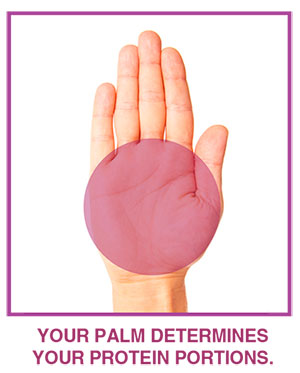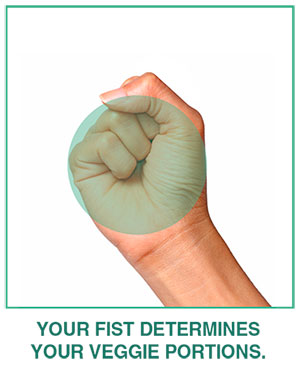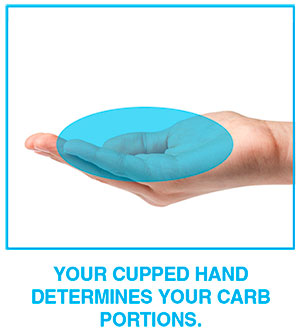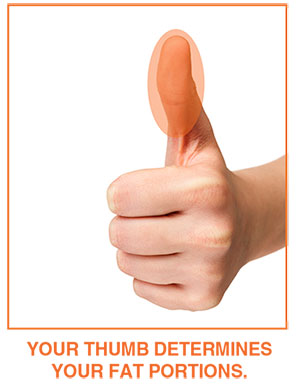Hand Portioning for Each Food Group

As a fitness professional or nutrition coach, you know calories matter. Fundamentally, human body weight is controlled by energy balance—calories in vs. calories out.
But having clients meticulously count calories and track macronutrients is not the solution in most cases. That approach is often tedious, inexact and unsustainable. It takes handbooks, websites, databases and math. Just to plan lunch.
While calories do count, it has become clear that counting them won’t help most people over the long term. However, we still want clients to be aware of how much they eat each day—and be able to easily adjust their intake to reach their goals.
Fortunately, there’s a better, simpler way. So put down the calculators. Put away the food scales. Turn off the calorie-counting apps. It’s time to stop counting calories.
At Precision Nutrition, we use a simple method that helps people build an awareness of what they’re eating. It’s easy, it’s portable, and it’s scaled to the size of the individual.
All you need are the ability to count to 2, and your own hand.
Here how it works:
• Your palm determines your protein portions.
• Your fist determines your veggie portions.
• Your cupped hand determines your carb portions.
• Your thumb determines your fat portions.
Of course, everybody is a little different. There’s not one “perfect” way of doing things, just as there’s not one “perfect diet” for everyone. But since bigger people tend to have bigger hands and smaller people have smaller hands, your own hand can be a personalized (and portable) measuring device for your food intake.
True, some people do have larger or smaller hands for their body size. Still, hand size correlates pretty closely with general body size. And that means that with this system most people’s meals and portions will scale to their body size.
Let’s break down how this works one food group at a time.
How Much Protein Do Clients Need?
First, let’s start with protein.
For protein-dense foods like meat, fish, eggs, cottage cheese and Greek yogurt, use a
palm-sized serving.
This means a serving has the same thickness and diameter as your palm. Each palm-sized serving provides approximately 20–30 grams of protein.
For men, we generally recommend six to eight palm-sized portions of protein each day. To simplify further, we generally suggest two palm-sized portions in each meal, assuming clients eat four meals per day.
For women, we generally recommend four to six palm-sized portions of protein each day. For simplicity, this works out to roughly one palm-sized portion in each meal (again, assuming four meals per day).
This helps clients meet their protein needs to build muscle, burn fat, improve recovery and boost performance.
How Many Veggies Do Clients Need?
For nonstarchy colorful vegetables (think broccoli, spinach, salad, carrots, etc.), use a
fist-sized serving.
Again, a fist-sized portion has the same thickness and diameter as your fist.
For men, we generally recommend six to eight fist-sized portions of vegetables each day. That comes out to roughly two fist-sized portions in each meal.
For women, we generally recommend four to six fist-sized portions of vegetables each day. This works out to roughly one fist-sized portion in each meal.
Of course, clients are free to eat more veggies, but just adding one fist-sized portion to each meal is a great starting place for many people.
How Many Carbs Do Clients Need?
For carbohydrate-dense foods—like grains, starches or fruits—use a
cupped hand
to determine your serving size. Each cupped handful provides approximately 20–30 g of carbohydrate.
For men, we generally recommend six to eight cupped handfuls of carbohydrate each day. This works out to roughly two cupped handfuls in each meal.
For women, we generally recommend four to six cupped handfuls of carbohydrate each day. This works out to roughly one cupped handful in each meal.
This gives clients enough carbs to fuel performance, maintain hormones and feel good without getting excessive.
How Much Fat Do Clients Need?
For fat-dense foods like oils, butters, nut butters and nuts/seeds, use your
entire thumb
to determine your serving size. A thumb-sized portion is the thickness and entire length of your thumb, and each serving provides approximately 7–12 g of fat.
For men, we generally recommend six to eight thumb-sized portions of fat each day. This works out to roughly two thumb-sized portions of fats in each meal.
For women, we generally recommend four to six thumb-sized portions of fat each day. This works out to roughly one thumb-sized portion in each meal.
This amount gives clients enough fats to support the immune system, maintain sex hormones and perform many other vital functions without being excessive.
Now Stay Flexible
Of course, just as with any other form of nutrition planning—including calorie counting—this serves only as a starting point. You can’t know exactly how your clients will respond in advance. So stay flexible, and help clients adjust their portions based on hunger, fullness, activity level and type, goals and, most importantly, results.
To read more about how clients can simplify dietary dilemmas by using their hands to control portion size, please see “Nutrition by the Handful: An Alternative to Counting Calories” in the online IDEA Library or in the April 2016 print issue of IDEA Fitness Journal. If you cannot access the full article and would like to, please contact the IDEA Inspired Service Team at (800) 999-4332, ext. 7.
Brian St. Pierre, MS, RD
Brian St. Pierre, MS, RD, is a nutrition expert at Precision Nutrition, the worldÔÇÖs largest online nutrition coaching company. Each year, the Precision Nutrition team takes small groups of trainers and coaches through the renowned PN Level 1 and Level 2 certi? cation programs.








